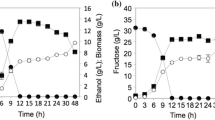Abstract
Glycogen, a major reservoir of energy in Saccharomyces cerevisiae, is found to be present as soluble and membrane-bound insoluble pools. Yeast cells can store excess glycogen when grown in media with higher concentration of sugar or when subjected to nutritional stress conditions. Saccharomyces cerevisiae NCIM-3300 was grown in media having ethanol concentrations up to 12% (v/v). The effects of externally added ethanol on glycogen and other carbohydrate content of yeast were studied by using alkali digestion process. Fermentative activities of cells grown in the presence of various ethanol concentrations (2–8% v/v) exhibited increase in values of glycogen and other carbohydrate, whereas cells grown with higher concentrations of ethanol (10–12% v/v) exhibited depletion in glycogen and carbohydrate content along with decrease in cell weight. Such inhibitory effect of ethanol was also exhibited in terms of reduction in total cell count of yeast grown in media with 2–16% (v/v) ethanol and 8% (w/v) sugar. These data suggest that, as the plasma membrane is a prime target for ethanol action, membrane-bound insoluble glycogen might play a protective role in combating ethanol stress. Elevated level of cell-surface α-glucans in yeast grown with ethanol, as measured by using amyloglucosidase treatment, confirms the correlation between ethanol and glycogen.


Similar content being viewed by others
References
Fleet GH (1981) Cell walls. In: Rose AH, Harrison JS (eds) The yeast, 2nd edn, 14, yeast organelles. Academic, London, pp 199–277
Manners DJ, Masson AJ, Patterson JC (1973) The structure of a β(1–3)-d-gluan from yeast cell walls. Biochem J 135:19–30
Fleet GH, Manners DJ (1976) Isolation and composition of an alkali soluble glucan from the cell walls of Saccharomyces cerevisiae. J Gen Microbial 94:180–192
Zlotnik H, Fernandez MP, Bowers B, Cabib E (1984) Saccharomyces cerevisiae mannoproteins form an external cell wall layer that determines wall porosity. J Bacteriol 159:1018–1026
Cabib E, Bowers B (1971) Chitin and yeast budding. Localization of chitin in yeast bud scars. J Biol Chem 246:152–159
Cabib E, Rothman-Denes LB, Huang KP (1973) The regulation of glycogen synthesis in yeast. Ann N Y Acad Sci 210:192–206
Smith ZG, Patil NB, Smith EE (1977) Two pools of glycogen in Saccharomyces. J Bacteriol 130(2):818–825
Jadhav JP, Dake MS, Patil NB (2006) Variations of two pools of glycogen and ethanol in Saccharomyces carlsbergenesis. Asian J Chem 18(2):1443–1450
Arvindekar AU (1995) Biochemistry of cell wall α-glucans in Saccharomyces. Ph.D thesis, Shivaji University, Kolhapur
Lillie SH, Pringle JR (1980) Reserve carbohydrate metabolism in Saccharomyces cerevisiae : response to nutrient limitation. J Bacteriol 143(3):1384–1394
Thomas DS, Rose AH (1979) Inhibitory effect of ethanol on growth and solute accumulation by Saccharomyces cerevisiae as affected by plasma membrane lipid composition. Arch Microbiol 122:19–55
Thomas DS, Hossack AJ, Rose AH (1978) Plasma membrane lipid composition and ethanol tolerance. Arch Microbiol 117:239–245
Nagodawithana TW, Whitt JT, Cutaia AJ (1977) Study of the feed back effect of ethanol on selected enzymes of the glycolytic pathway. J Am Soc Brew Chem 35:179–183
Leao C, Van Uden N (1984) Effects of ethanol and other alkanols on passive proton influx in the yeast Saccharomyces cerevisiae. Biochim Biophys Acta 774:43–48
Patel GB, Ingledew WM (1975) The relationship of acid soluble glycogen to yeast flocculation. Can J Microbiol 21:1608–1613
Masschelein CA, Ramos CJ, Castau C, Devreux A (1963) Mechanism of phenotypic variations in the flocculence character of yeast. J Inst Brew 69:332–338
Lloyd JB, Whelan WJ (1969) An improved method for the enzymatic determination of glucose in the presence of maltose. Anal Biochem 30:467–470
Dubois M, Gilles KA, Hamilton JK, Robers PA, Smith F (1956) Colorimetric method for determination of sugar and related substances. Anal Chem 28:350–356
Arvindekar AU, Patil NB (2002) Glycogen—a covalently linked component of the cell wall in Saccharomyces cerevisiae. Yeast 19:131–135
Agudo LD (1992) Lipid content of Saccharomyces cerevisiae strain with different degrees of ethanol tolerance. Appl Microbiol Biotechnol 37:647–665
Barbosa MF, Yomano LP, Ingram LO (1994) Cloning, sequencing and expression of stress genes from the ethanol producing Zymomonas mobilis: the groESL operon. Gene 148:51–57
Piper PW (1995) The heat shock and ethanol stress responses of yeast exhibit extensive similarity and functional ovelap. FEMS Microbiol Lett 134:121–127
Gille C, Sigler K, Hofer M (1993) Response of catalase activity and membrane fluidity of aerobically grown Schizosaccharomyces pombe and Saccharomyces cerevisiae to aeration and presence of substrates. J Gen Microbiol 139:1627–1634
Alexandre H, Berlot JP, Charpentier C (1994) Effect of ethanol on membrane fluidity of protoplasts from Saccharomyces cerevisiae and Kloeckera apiculata grown with or without ethanol, measured by fluorescence anisotropy. Biotechnol Tech 8:295–300
Alexandre H, Rousseaux I, Claudine C (1993) Ethanol adaptation mechanism in Saccharomyces cerevisiae. Biotechnol Appl Biochem 20:173–183
Mansure JJ, Panek AD, Crowe LM, Crowe JH (1994) Trehalose inhibits ethanol effects on intact yeast cells and liposomes. Biochim Biophys Acta 1191:309–316
Leslie SB, Israeli E, Lighthart B, Crowe JH, Crowe LM (1995) Trehalose and sucrose protect both membranes and proteins in intact bacteria during drying. Appl Environ Microbiol 61:3592–3597
Acknowledgments
We are grateful to Shivaji University, Kolhapur for a grant from the Departmental Research Fellowship Scheme and for providing the research facilities to carry out this work.
Author information
Authors and Affiliations
Corresponding author
Rights and permissions
About this article
Cite this article
Dake, M.S., Jadhv, J.P. & Patil, N.B. Variations of two pools of glycogen and carbohydrate in Saccharomyces cerevisiae grown with various ethanol concentrations. J Ind Microbiol Biotechnol 37, 701–706 (2010). https://doi.org/10.1007/s10295-010-0713-x
Received:
Accepted:
Published:
Issue Date:
DOI: https://doi.org/10.1007/s10295-010-0713-x




